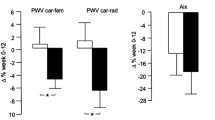Summary
Since there is only scanty, indirect information about the mechanism of the hypotensive effect of spironolactone, 9 patients with essential hypertension were studied according to a randomised double-blind, cross-over protocol. Spironolactone 100mg b.i.d. and placebo were each given for one month and the following parameters were studied: blood pressure, heart rate, response to cold pressure and hand-grip tests, as well as blood flow in the calf and finger vessels. Flow in the calf and fingers representing muscle and skin arteries, respectively, was measured semicontinuously with an ECG-triggered venous occlusion plethysmograph. After spironolactone there was a significant decrease in the systolic and diastolic blood pressures in the supine, sitting and standing positions; the sitting systolic and diastolic blood pressure decreased by (mean ± SE) 27±4mm Hg (p<0.001) and 11±4mm Hg (p<0.02), respectively. No orthostatic response was observed. Heart rate remained unchanged. Blood flow through muscle and skin vessels increased in 6 out of 9 patients, and in these patients calculated vascular resistance in these areas decreased. Spironolactone did not significantly change the response of systemic blood pressure to the handgrip and cold pressure tests. The present data confirm the hypotensive properties of spironolactone and show that this effect is associated with dilatation of muscle and skin arteries in many but not in all the patients. The data do not support the hypothesis that spironolactone decreases the responsiveness of systemic blood pressure to orthosympathetic stimulation.
Similar content being viewed by others
References
Bevegård S (1977) The effect of four months' treatment with Spironolactone on systemic blood pressure, cardiac output and plasma renin activity in hypertensive patients. Acta Med Scand 202: 373–377
Clement DL, Brugmans J (1980) Reactive hyperemia in patients with intermittent claudication and correlation with other diagnostic methods. Angiology 31: 189–197
Clement DL, Shepherd JT (1976) Regulation of peripheral circulation during muscular exercise. Progr Cardiovasc Dis 15: 23–31
Dustan HP, Cumming GR, Corcoran AC, Page IH (1959) A mechanism of chlorothiazide-enhanced effectiveness of antihypertensive ganglioplegic drugs. Circulation 19: 360–365
Dustan HP, Tarazi RC, Bravo EL (1974) Diuretic and diet treatment of hypertension. Arch Intern Med 133: 1007–1013
Ewing DJ, Campbell IW, Burt AA, Clarke BF (1973) Vascular reflexes in diabetic autonomic neuropathy. Lancet 2: 1354–1356
Falch DK, Johansson R, Ødegaard AE, Norman N (1979) Haemodynamic effects of treatment and withdrawal of Spironolactone in essential hypertension. Scand J Clin Lab Invest 39: 159–165
Frohlich ED, Schnaper HW, Wilson IM, Freis ED (1960) Hemodynamic alterations in hypertensive patients due to chlorothiazide. N Engl J Med 262: 1261–1263
Hines EA, Jr (1940) The significance of vascular hyperreaction as measured by the cold pressor test. Am Heart J 19: 408–416
Mendlowitz M, Naftchi NE, Gitlow SE, Wolf RL (1968) The effect of Spironolactone on digital vascular reactivity in essential hypertension. Am Heart J 76: 795–798
Ochs HR, Greenblatt DJ, Bodem G, Smith WT (1978) Spironolactone. Am Heart J 96: 389–400
Safar M, Tomowa J, Menard J, Millièz P (1972) Hémodynamique du syndrome de Conn: Etude après Spironolactone et après traitement chirurgical. In: Brendel W et al. (eds) Extrarenal activity of aldosterone and its antagonists. Excerpta Medica, Amsterdam, p 77
Shepherd JT (1963) Physiology of the circulation in human limbs in health and disease. WB Saunders, Philadelphia
Wollam GL, Gifford RW, Jr, Tarazi RC (1979) Antihypertensive drugs: Clinical pharmacology and therapeutic use. In: Brogden NR (ed) Antihypertensive drugs today. MTP Press, Lancaster, pp 1–67
Author information
Authors and Affiliations
Rights and permissions
About this article
Cite this article
Clement, D.L. Effect of spironolactone on systemic blood pressure, limb blood flow and response to sympathetic stimulation in hypertensive patients. Eur J Clin Pharmacol 21, 263–267 (1982). https://doi.org/10.1007/BF00637611
Received:
Revised:
Accepted:
Issue Date:
DOI: https://doi.org/10.1007/BF00637611




